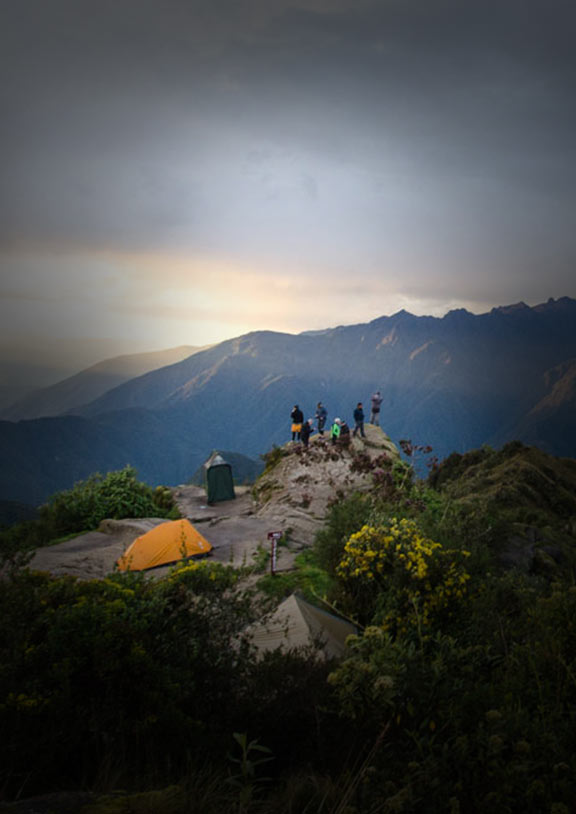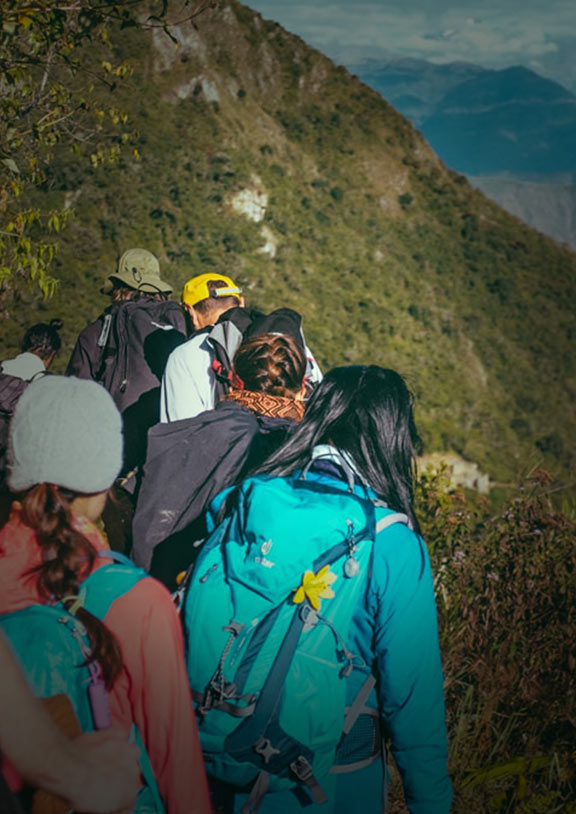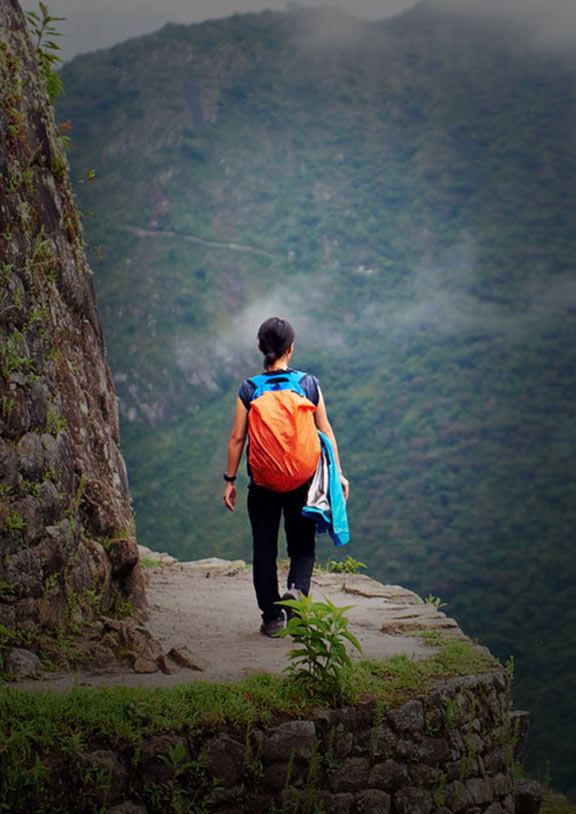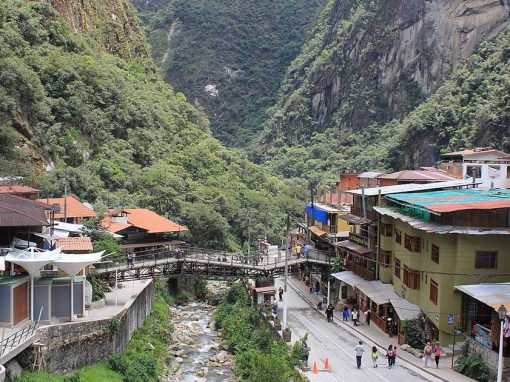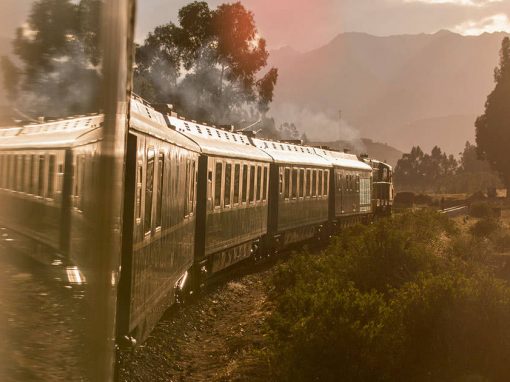The most famous attraction in Peru, Machu Picchu, entices visitors from around the world. The ruins sit on an isolated mountain ridge where the Andes Mountains meet the Amazon Rainforest. This enchanting location limits the ways for how to get to Machu Picchu. Especially if your time is limited, coordinate all the legs of your journey and have tickets booked before you arrive.
Overview
The mountainous geography and narrow river valleys of the cloud forest around Machu Picchu limit access to the region. There are no roads that connect the isolated Inca ruins with Cusco and towns in the Sacred Valley. Consequently, the journey is not as simple as taking a direct bus, taxi, or car drive there.
The three legs of transport to Machu Picchu are outlined below.
- First, you need to get to Cusco.
- Then, from Cusco, you can choose to ride the train or trek. Most travelers enjoy the comfortable train ride to the Machu Picchu Station in Aguas Calientes. Treks also pass through Aguas Calientes before visiting the ruins, except for the Inca Trail, which ends at the Sun Gate entrance to Machu Picchu.
- Finally, take a short bus ride from Aguas Calientes to Machu Picchu for your tour. Have fun discovering what makes this 15th century Inca landmark one of the New Seven Wonders of the World!
Peru For Less arranges each step of your journey to Machu Picchu as part of any customized vacation package to Peru.
Steps to Machu Picchu
The following are the three necessary steps to arrive at Machu Picchu. The exact route you take depends on your preferences, trip length, and budget.
Step 1: Getting to Cusco
Cusco is the starting point in the Andes for planning transport to Machu Picchu. Most travelers fly to Cusco and land at the Alejandro Velasco Astete Cusco International Airport (CUZ). Others arrive by bus. In general, renting a car in Peru to drive to Cusco is not suggested because of the curvy mountain roads and stretches of isolated conditions.
From Lima to Cusco:
Lima is the coastal capital city of Peru. Travelers from abroad pass through immigration at Jorge Chavez International Airport in Lima and then take a domestic flight to Cusco. Flying from Lima to Cusco is a direct one and half hour flight.

The plaza in the cultural and historic heart of Cusco. Photo by Alicia Gonzalez
The bus from Lima to Cusco takes twenty-one hours and longer. Long-distance bussing is appealing for budget travelers who are not short on time. However, travelers coming to Peru for a week or two typically want to save time between destinations and pay the extra fare to fly from Lima to Cusco.
From Arequipa to Cusco:
There are regular connecting flights between the Manuel Ballon International Airport in Arequipa and Cusco. It takes one hour to fly between destinations. Bussing takes nine hours.
From Puno & Lake Titicaca to Cusco:
Puno is a city on the western shores of Lake Titicaca in Peru. It takes about one hour to fly nonstop from Puno to Cusco. The Inca Manco Cápac International Airport is the closest option to Puno but still a one hour drive from the city. Account for the cost of the airport transfer when weighing the pros and cons of flying between destinations.
Often, our Travel Advisors suggest an eight-hour sightseeing bus tour that runs from Cusco to Lake Titicaca. The PeruRail Titicaca is a luxury train that operates full-day trips between Cusco and Puno, but weekly departures are limited.
From Puerto Maldonado to Cusco:
The Peruvian Amazon destination of Puerto Maldonado is a nonstop fifty-minute flight to Cusco. Taking the bus is a grueling ten-hour ride.
Cusco to Aguas Calientes
Options for continuing onto Machu Picchu from Cusco narrow down. The majority of travelers prefer the comfort and ease of the reliable train system. Still, plenty of adventure goers choose to do a Machu Picchu trek.
Train Versus Trek
| TRAIN | INCA TRAIL | ALTERNATIVE TREKS | |
| OPTIONS: | PeruRail or Inca Rail | 2-day or 4-day | Salkantay, Lares, or Choquequirao |
| LENGTH: | 1.5 to 4.5 hours (one way) | 2 or 4 days | 4 days and more |
| BEGINS: | Cusco or Sacred Valley | Sacred Valley trailheads | Sacred Valley trailheads |
| SERVICES: | Luxury to budget tickets | Group or private | Group or private |
| MACHU PICCHU ARRIVAL: | Arrive in Aguas Calientes, then bus to the main entrance. | Sun Gate to Machu Picchu. | Pass through Aguas Calientes and take the bus to the main entrance. |
Train to Machu Picchu
Train service does not take you directly to Machu Picchu but rather to the town of Aguas Calientes at the foot of the mountaintop ruins. PeruRail and Inca Trail operate trains for tourists. Both companies offer a comfortable ride in modern cars, schedule variance, and service levels to suit first-class and budget preferences.
Travelers commonly board the train in Cusco at the Poroy Station. This station is a thirty-minute drive from the historic center of the city and our team can arrange for a private transfer to pick you up from your Cusco hotel. Others depart from train stations in the Sacred Valley, which cuts down on travel time to the Machu Picchu Station in Aguas Calientes.
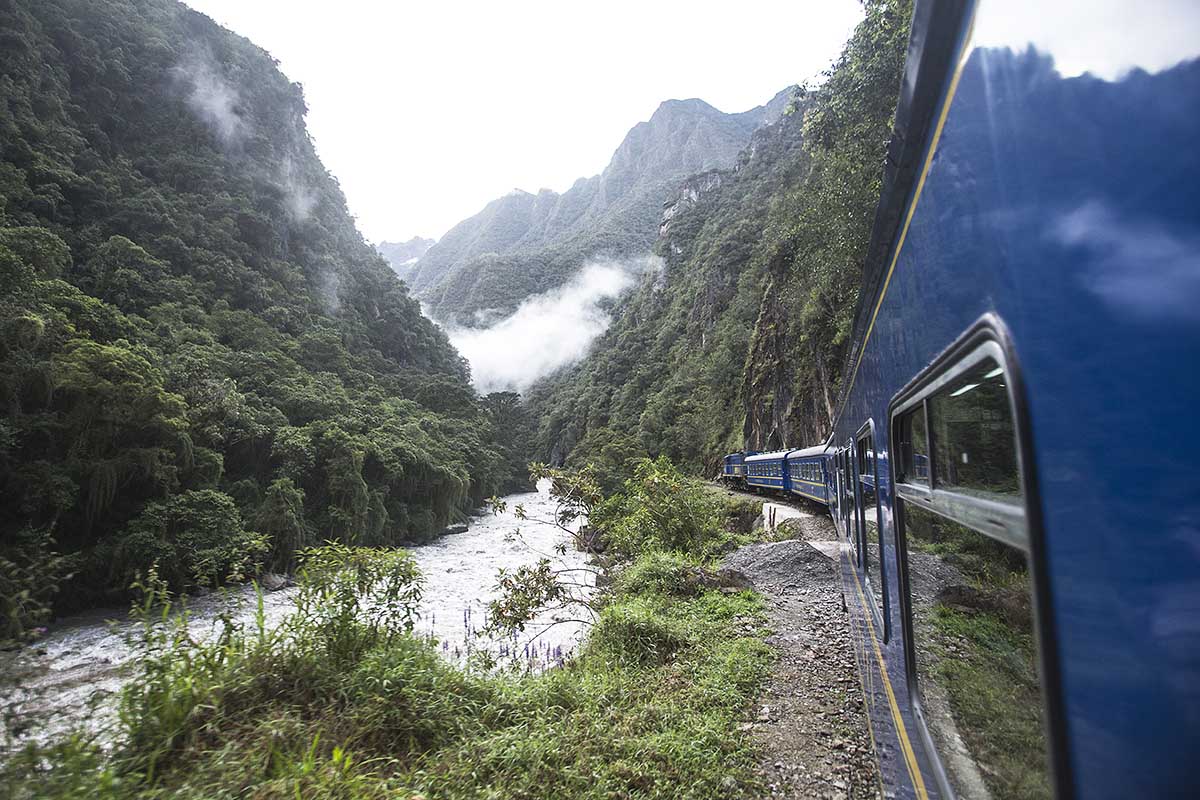
The train ride to Machu Picchu is stunning. Photo by Peru For Less
Cusco Stations and Times:
- San Pedro Station – Aguas Calientes: 4.5-hour train ride
- Poroy Station – Aguas Calientes: 3.5-hour train ride
Sacred Valley Stations and Times:
- Urubamba Station – Aguas Calientes: 2.5-hour train ride
- Ollantaytambo Station – Aguas Calientes: 1.5-hour train ride
Machu Picchu Trekking Packages
Instead of taking the train, outdoor enthusiasts can do a multi-day trek to Machu Picchu. The Inca Trail is the most iconic hike to Machu Picchu and the only option that permits entrance into the famous ruins on foot through the Sun Gate. All other trails are called Inca Trail alternatives or alternative treks to Machu Picchu and end close to (not at) the ruins.
Our Inca Trail tours include an experienced English-speaking guide and outdoor team, daily meal preparation, and camping equipment. Itineraries to Machu Picchu vary in length and highlight diverse Andean scenery.
Inca Trail Versus Alternative Treks
Salkantay, Lares, and Choquequirao are other trekking tours that you can take to Machu Picchu. These trails go through the Sacred Valley similar to the Inca Trail and highlight the Andean region, lesser-known Inca sites, and small mountain villages. However, unlike the Inca Trail, the all-inclusive packages for alternative treks are organized with a hotel stay in Aguas Calientes and then a Machu Picchu tour on the last day.

Abundant and varied beauty is a highlight of the Salkantay Trek. Photo from Shutterstock
The alternative treks do not require a special permit like the Inca Trail and tend to be less crowded during the peak dry season (June to August). For some, these desirable conditions outweigh choosing the Inca Trail.
Every year the Inca Trail is closed in February for clean-up and preservation, and no permits are available. The month of February falls in the middle of the wet season (November to March) in the Andes and the low season for planning a trek in Peru. Choose Salkantay, Lares, or Choquequirao if dates in February are your desired time to trek.
Skip down to the Hiking the Inca Trail section to learn more about this classic route to Machu Picchu.
Alternative Treks
Salkantay Trek to Machu Picchu
- Trail Highlights:
+ Varied and abundant beauty
+ Camp under the watchful eye of the Andean mountain spirit Apu Salkantay
+ Trek past local farms - Itinerary: 5 days
- Overnights: 3 nights camping and 1 night at a hotel in Aguas Calientes
- Detailed Salkantay Trek Itinerary
Luxury Salkantay Lodge-to-Lodge Trek
- Trail Highlights:
+ Varied and abundant beauty
+ Overnight stays at remote luxury Andean lodges
+ Gourmet meals, beverage service, hot tubs, and more - Itinerary: 7 days
- Overnights: 5 nights at Andean lodge and 1 night at a hotel in Aguas Calientes
- Detailed Salkantay Lodge-to-Lodge Trek Itinerary
Lares Trek
- Trail Highlights:
+ Visit and interact with local farmers and Andean weavers
+ Lares hot springs
+ Amazing mountain views - Itinerary: 4 days
- Overnights: 2 nights camping and 1 night at a hotel in Aguas Calientes
- Detailed Lares Trek Itinerary
Choquequirao Trek
- Trail Highlights:
+ Visit Machu Picchu and the significantly larger Inca ruins of Choquequirao
+ Less trodden trail from the mountains towards the lower jungle of Peru - Itinerary: 8 days
- Overnights: 6 nights camping and 1 night at in Aguas Calientes
- Detailed Choquequirao Trek Itinerary
Aguas Calientes to Machu Picchu
Whether you arrive in Aguas Calientes by train or via the Salkantay, Lares, or Choquequirao treks, the last step of the journey to Machu Picchu is to go uphill to the main visitor entrance. The town has limited motor transport. Walking is the only way to get to local restaurants, hotels, and shops, and the only ride you can catch up to the main entrance to Machu Picchu is by bus. There are no taxis or independent drivers to offer alternative transport.

The town of Aguas Calientes. Photo by Daniella Beccaria
Taking the Shuttle Bus
Buses run daily between Aguas Calientes and Machu Picchu. In total, the ride takes twenty-five to thirty minutes. Passengers starting line up at the bus station in Aguas Calientes on Avenida Hermanos Ayar between 5:30 a.m. and 3:30 p.m. Buses to Machu Picchu run every ten minutes or as soon as they are full. The same bus fleet also ferries passengers back to Aguas Calientes at regular intervals.
Two tickets are required for a round trip bus from Aguas Calientes to Machu Picchu. Machu Picchu bus tickets are available on the Consettur website and sales offices.
Hiking
Once you reach the town of Aguas Calientes you’re within walking distance of Machu Picchu. Some travelers skip the bus ride and hike for about two hours up to the main visitor entrance. This route is mainly stairs and follows the switchback road that leads up the mountain. The hike is strenuous but rewarding.
Hiking the Inca Trail
The classic 4-day Inca Trail, also known as Camino del Inca in Spanish, takes four days to complete. The class trek begins at Km 82 of the train tracks in the Sacred Valley. Here, officials check permits and the pack weight of Inca Trail porters. On the journey, cross mountain passes, witness beautiful Andean scenery, and take quick breaks at Inca ruins along the trail.
Walking through the Sun Gate is the grand finale. Gazing down at the Machu Picchu citadel for the first time after the long journey is indescribable.

The famous Inca citadel. Photo by Daniella Beccaria
There are daily restrictions to the number of trekkers allowed on the trail. The Peruvian government requires travelers to obtain a permit in advance to undertake this trek. Make sure you ask your Travel Advisor about securing a permit and trekking package.
Check out our Inca Trail Travel Guide to plan your trekking adventure. Learn about the history of the trail, sites along the way, and when to go.
Inca Trail Itineraries
Classic 4-Day Inca Trail
- Itinerary: 4 days trekking to Machu Picchu
- Overnights: 3 nights camping
- Walking distance: 31 miles (50 km)
- Detailed 4-Day Inca Trail Itinerary
2-Day Inca Trail
- Itinerary: 2 days (Day 1 of trekking and Day 2 tour)
- Overnights: 1 night at a hotel in Aguas Calientes
- Walking distance: 7 miles (11 km)
- Detailed 2-Day Inca Trail Itinerary
Planning Tips
- If you take the train to Machu Picchu, consider staying overnight in Aguas Calientes. Organizing your trip this way helps break up the travel time to get there, and you can enjoy your Machu Picchu experience at a more relaxed pace. Planning a day trip to the famous ruins from Cusco is exhausting. Since the train from Cusco arrives in Aguas Calientes around noon and you have to catch the return trip around 5 p.m., there isn’t much time to explore the citadel if you plan on making it back the same day. Talk to your Travel Advisor about Machu Picchu Hotels in Aguas Calientes.
- Give yourself time to acclimate. Cusco is 11,155 feet (3,400 m) above sea level, and altitude sickness is a common concern. Upon arrival, take it easy in Cusco for the first day or two. Drink water, walk stairs slowly and eat light meals. The elevation of Machu Picchu is lower at 7,970 feet (2,430 m).
- Only consider trekking if you are in decent physical condition. Trekking for four days through the mountains is not easy. Avoid this option if you are in poor health.
- If possible, book all the entry tickets and transportation in advance. This advice goes for both getting to Machu Picchu by train or trekking. For many, the best time to visit Machu Picchu is June through August.
Several details from transportation to hotel reservations go into planning a Peru trip. Contact us, and our Travel Advisors will use their travel expertise to plan a vacation customized just for you.
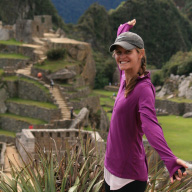
Britt is a California native who now calls Peru home. She is a traveler with a passion for all things outdoors, scuba diving, and capturing memories with her camera.




